The Secret To Successful Sailfish Trips In The Florida Keys
One specific species the Main Attraction Charter Fishing Team is known for catching is the Atlantic Sailfish. This speedy billfish is one of our favorite sportfish to catch in the Florida Keys. It doesn’t matter how often you catch and release one; the next is always just as exciting. Captain Marty Lewis of the Main One has caught thousands of Sailfish over the past few decades. When asked if he ever grows tired of catching Sailfish, his response was: “Absolutely not! It is always fun and exciting. I get to help people catch their first Sailfish all the time, which means I get to share in that excitement and joy with them. It is a rewarding experience.”
Depending on where you are fishing for Sailfish the methods used can vary significantly.
It is pretty common in other parts of the world to target Sailfish trolling lures or dead baits such as brined Ballyhoo. Even in other parts of Florida, such as West Palm Beach, most Sailfish are caught on dead baits. Down here in the Keys, there is a higher concentration of fishing boats hunting for Sailfish. The added pressure on these fish makes live bait essential to trigger bites and to compete with the other boats. This is why we feel that knowing what bait to use and when is the secret to successful Sailfish Trips in the Florida keys.
To consistently catch Sailfish down here, you need to know what method of presenting live bait is appropriate for each situation. In this article, we will share the factors that need to be considered when deciding which live bait to present to Sailfish in the Florida Keys.
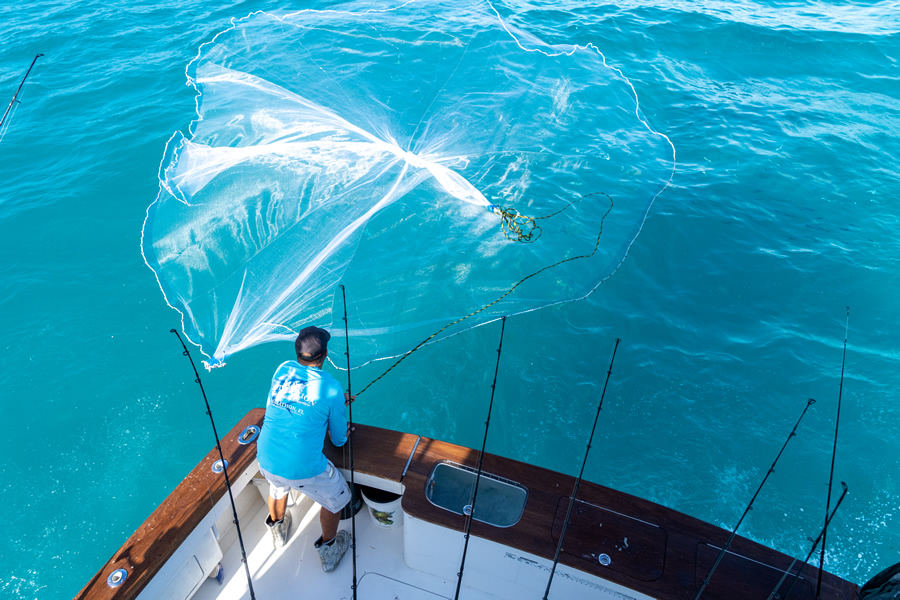
Captain Marty Lewis throws a cast net on ballyhoo before heading offshore to catch Sailfish.
Availability
Before we get into all the different live baits we use to catch Sailfish, remember these are ideal scenarios. Fortunately for us, the baits available throughout the year are often precisely what the Sailfish are eating. If you happen upon a Sailfish and don’t have the best bait for that situation, you should still present whatever you have to try and trigger a bite.
We have seen Sailfish turn down the most perfect of baits before, and we have also seen Sailfish eat some unexpected things. If a Sailfish isn’t hungry or interested in feeding, getting it to eat bait will be a challenge no matter what you do. The edge we are seeking to gain is to increase the percentage chance of finding a Sailfish and triggering a bite.
Our Fishing Charter boats use different types of live bait depending on the scenario and the time of year. Since Sailfish can be caught year-round, your crew needs to know what bait to have on your vessel if an opportunity presents itself.
One of the reasons we stressed the importance of preparation in our 2019 Article on the secrets to successful Sailfish tournament trips is the need to be ready for anything. It is common to be hunting for other pelagics like Tuna or Mahi and stumble upon a hungry Sailfish. You could ride to the Reef to go Yellowtailing in 30 feet of water and spot a hungry sailfish primed to eat your bait!
Have you ever wondered why boats have multiple live wells? Well, it’s to carry a large quantity of live bait and separate the different species. Certain species will beat other fish up if kept together. And you don’t want to overload your livewell either, as crowding them will cause a lack of oxygen and death.
Catching great baits for our Fishing Charter customers means significant time, effort, and fuel to keep live baits on our vessels. One trick to keeping baits alive the longest is that once caught individually and not in a cast net; we put them in a bait cage.
A bait cage is an enclosure that sits in the water at our docks where we keep baits and let them adjust to life in captivity. We feed them and keep them just like pets, living in the bait cage for weeks or months before using them on charters and tournaments.
These hardened baits are much stronger than the ones we might net for same-day use. And once taken out on a fishing trip, any unused hardened bait gets to stay in our live wells overnight because they are tough now, and they can survive the night and be good for use the next day and the next.
Although you can catch plenty of bait before your fishing trip, bait loses their slime coat when caught, so when you pen them, they have a chance to rebuild their slime coat, making them stronger and hardier.
Herring / Pilchards / Sardines
This is not so much a specific type of bait fish but more of a family named clupeidae. This family comprises herrings, shads, sardines, and menhadens, all very popular bait choices among fishermen throughout the country. Here in the Keys, we primarily catch Pilchards, Herring, and Sardines for Sailfishing in the Fall and Winter. These baits are also a great way to raise Tuna year round.
Pilchards
Pilchards are often our go-to bait as they can be found in the shallows in great quantity in the wintertime, presumably in search of warmer water. We catch them year round, and use them for Sailfish and everything else. They look similar to threadfin herring in shape and color but do not have a tassle off their back fin. If you are catching pilchards and notice some of them have an orange coloration or hue, these are what we call Sandy Keys. They can also work as bait but aren’t nearly as hardy as regular pilchards; their scales come off much easier, which means they will only last for a short while.
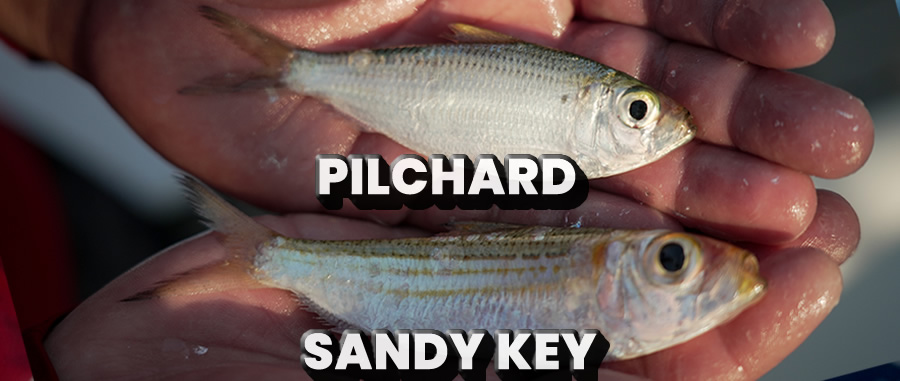
Our crews leave early in the morning, and as the sun rises, they look for Pelicans diving on schools of bait for breakfast. After throwing our large 14-foot cast nets on these baits, we head back in, fill our boats with bait and go fishing.
In the summer you can find pilchards near beaches and other shallow areas, but they aren’t schooled up densely enough for the cast net to work. Instead, after attracting the bait fish to the boat with a block of chum, our crews spend some afternoons catching Pilchards by hand using a small rod and reel with a multi-hook rig called a Sabiki.
A Sabiki rig has small feathers like a fly with a hook. These rigs do not need bait on them when the Pilchards are hungry, and you can hook several at a time. Once dehooked and dropped in the well, these hairhooked baits last much longer than the winter ones we net.
Threadfin Herring
Threadfin herring look similar to Pilchards, but they are especially fragile, so our crew members always have to Sabiki them. Captain Marty recommends never throwing a net on them or scooping them out of the well to transfer them. Instead, we take them gingerly, one fish at a time.
Scraping any netting against the body of any baitfish in the keys will lower its survivability because it knocks off their scales and slime coats, essentially their armor. It is not even an option for the more delicate baits as it will kill them right away. While the Sabiki rig takes longer, the baits will last much longer, and those are the baits we prefer to keep in the cage.
A Threadfin looks like a very large pilchard. They have a long thread hanging off their tail and a black spot near their gills.
Sardines
Sardines are a fantastic bait for Sailfish; they are oily and give off a potent odor in the water that gets most predators fired up. These baits however are less readily available than Pilchards. Captain Marty catches these on Wrecks and other structures. But they are considered more of a treat than a consistent bait option.
The Clupeidae family offers us bait year-round with the most consistency, and Sailfish love to eat them, a perfect combination!
Ballyhoo
Ballyhoo are members of the halfbeak family. Their elongated lower jaw has a beak or a bill as some call it. This does not make a ballyhoo a billfish, nor is it a juvenile Sailfish, as beginner anglers sometimes confuse it for.
When Sailfish chase a school of Ballyhoo, the school will often take flight to escape, which looks like a shower of bait. In the Fall and Winter, when the bait is closer to land, so are the predators that eat them. When Sailfish are close to the Reef showering schools of Ballyhoo, then our boats are likely offering the same bait to the Sailfish they catch.
While Ballyhoo are one of the most fragile live baits that we keep for Sailfishing, they are a solid option when the schools of pilchards have moved out of the shallows.
Using a cast net to acquire these baits for fishing lowers the lifespan of a Ballyhoo even more significantly than with pilchards. We often catch them by Sabiki first while anchored on the Reef and place those baits in a separate livewell. Once we have caught enough on Sabiki we throw the cast net on them to get a large quantity in a different live well before heading off to fish. Then we use the netted baits first since they will only last for a few hours. Towards the end of the day, we will only have Sabiki caught baits remaining. The Ballyhoo that doesn’t make it ends up brined for trolling or frozen for cut bait to ensure nothing goes to waste.
We do not store Ballyhoo in bait cages because their beaks will get caught in the netting of the cage and snap them off and injure and eventually kill them. This is also why they do not last very long in the live well. Captain Marty built round custom live wells on his boat so the Ballyhoo can swim in a smooth circle without banging into flat walls, this increased their survivability significantly.
Cigar Minnows
Another great bait that gets tough as nails after doing a stint in the cage. These are aggressive baits available year-round on the Reef. They are often right behind the chum bag, eating fearlessly as the Mate plucks them right out of the water one by one with a Sabiki rig.
These baits swim hard which is great for when the currents are strong or you need something lively in the kite rig. Captain Marty calls them turbo baits because they swim for their lives when predators appear, making them even more enticing.
Goggle Eyes
After a few weeks of hard time in the cage, Goggle eyes are one of the toughest baits you can have in your arsenal. They are also one of the best baits to use in the Keys because it seems like everything likes to eat a Goggle eye. But like most good things, you have to put a bit more effort into catching Goggle eyes.
It helps to have a big boat like Captain Marty does, and knowing how to find them of course! When Captain Marty needs Goggle eyes he takes the Main One out late at night in anywhere from 75-200 feet of water. Once he finds them schooled up, the crew members drop Sabikis rigs that are much larger than the ones used for Pilchard or Ballyhoo. We use only R & R tackle Sabikis for this purpose; they work the best (see below). As the lead reaches the bottom you’re often getting bites and need to start winding up immediately. Pulling 2 or 3 Goggles up on the Sabiki at a time is not unusual! The crew begins at sunset and fishes until the wells are full, often getting back as late as 3 or 4am. Now that is dedication!
If something special is behind your boat, Goggle eyes are rarely the wrong choice as a bait.
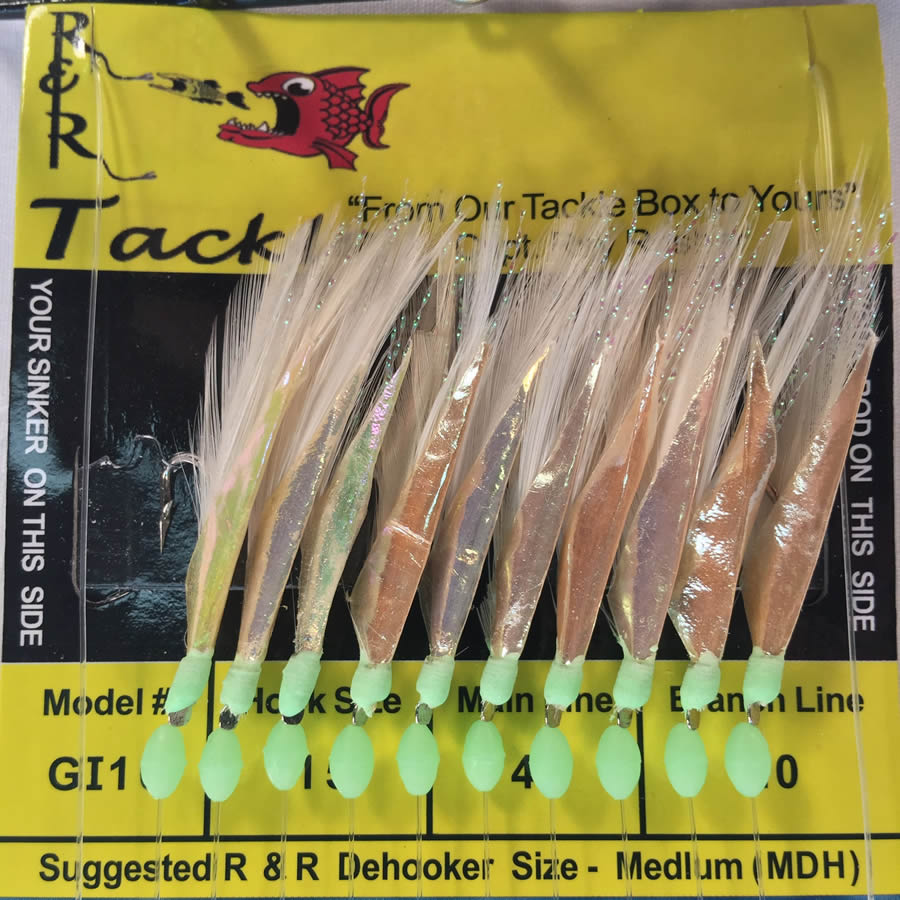
Captain Marty likes to use the GI10 Bait Rig; size 15 hooks with white feather & fish skin sabiki to catch Goggle Eyes.
Alternative Baits
While the recommended baits have the highest chance of success, other options exist. If you are in a jam and don’t have any of the baits we recommended, you can try whatever you have. You can only hook a fish if you have a hook in the water, so grab whatever legal bait you have from the well and toss it out there.
When live bait is tough to find, throwing a block of chum in a fish trap and waiting till morning will often yield Pinfish, which may work in multiple scenarios. Clipping off the sharp fins or pins on their backs with some scissors makes them go down a predators throat a lot easier. Have some live Mullet in the well for a Tarpon trip in the evening? If you see Sailfish and have no other bait, toss it out there! A hungry Sailfish might even eat a Blue Runner on the right day. Clipping a Blue Runner’s tail will cut down on its ability to run, making them easy quarry to a hungry Sailfish. On the right day, a Sailfish could eat anything given the right scenario; we have even seen Sailfish eating Yellowtail Snapper on the Reef!
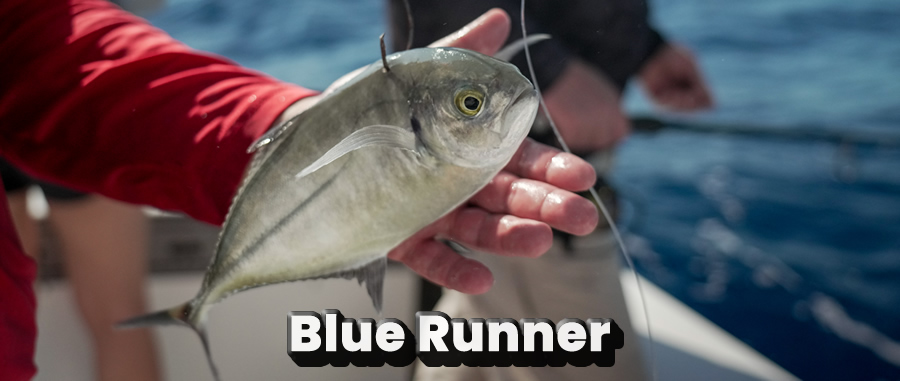
Depending on weather conditions, certain baits are better to use. For example, let’s say you are kite fishing for a tournament and you’re experiencing high winds which is causing the seas to be larger than normal, you want a heavier/hardier bait, such as a goggle eye or a cigar minnow.
How you rig your baits is also important but that will be another article in the near future. A quick note on rigging baits, where you hook a bait will affect how it swims if you have a well full of pilchards, experiment with where you hook them and see their behavior. For instance, if the fish are deeper down, hooking them in the belly will cause them to swim down. Get out there and experiment by hooking them and observing their behavior. Our crews will hook a bait in the nose, chin, shoulder, back, tail, or belly depending on the scenario.
We will be writing a bait and lure reference guide in 2023 which will touch on this in greater detail.
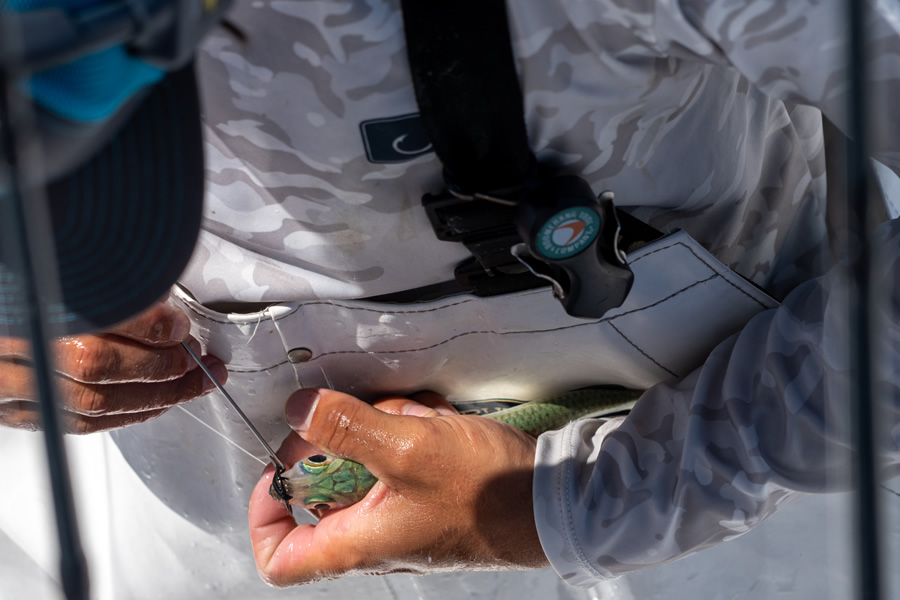
A Main Attraction Mate bridles a large pilchard for kite fishing.
Presentation of Bait
So you know what bait you can use and what time of year you might find them, but how do you put them in front of a Sailfish?
Kite fishing
Kite Fishing is a style of presenting bait to Sailfish and other pelagic species often in the winter time and sometimes in the spring. The Kite is attached to a strong braided line attached to a short rod and reel combo. As we let the kite out we clip lines from the rods and reels in our rocket launcher to the braided line of the kite. This might sound complicated but it is quite simple to do. It can, however, get complex quickly when you have multiple kites in the air and many lines in the water!
The primary reason why we kite fish in the winter is because we can. Only a few months of the year do we have enough wind to fly a kite. On days when the wind is just a touch too slow or inconsistent, we can use a helium balloon to assist the kite in its flight.
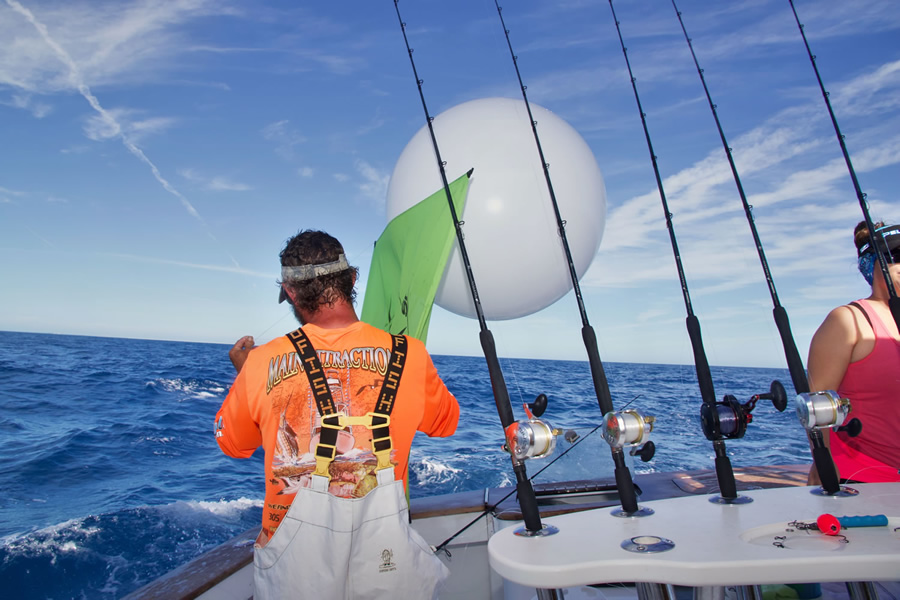
Our crews use helium balloons when their kites need a little boost.
Since the bait is on the Reef this time of year, so are predators like Sailfish. And since they are eating live baitfish, presenting them with one in the same area makes sense.
The Kite flies way back behind our boats to allow us to have fishing lines dropped into the water directly from above. This keeps the leaders out of the water where it would be visible to the fish. The bait now looks like it was separated from its school and is stuck near the surface, struggling to get away; its vulnerability makes it look like an easy meal. Easy meals are often an irresistible snack to a hungry Sailfish. How long you can keep a bait in the water on the kite lines depends on the hardiness of the species, the condition of the bait, and the strength of the wind and current.
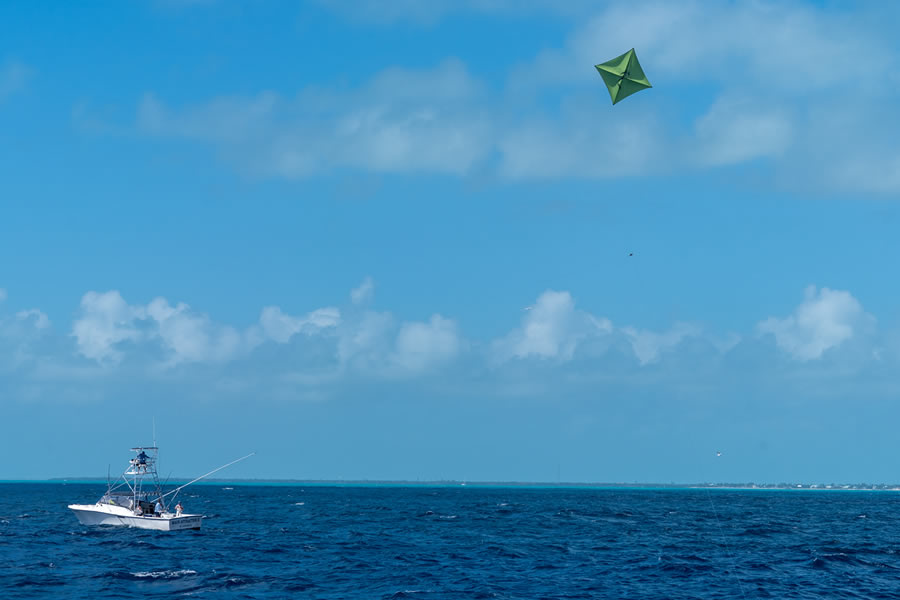
Kite Fishing lets you put baits way back behind the boat away from your short lines.
Our clients love to catch Yellowtail Snapper on the Reef in the winter. Yellowtail Snapper are notorious for being leader-shy. The Kites allow us to keep live baits in the water to lure a sailfish while still being able to reef fish without spooking the snapper. The perfect combination!
We don’t just Kite Fish on the Reef in the winter. We also kite fish offshore when there is enough wind. In this scenario, the purpose of the kite is to help us raise Sailfish, while covering a larger surface area of water. The kites basically act like outriggers allowing us to add more baits in the water without tangles. Most vessels can fly two kites at a time, with at least three lines per kite. If you aren’t sure what bait is best you can always switch up the different types of live bait on each kite line. For instance, you could put a goggle eye on your left long, a pilchard on the left middle, then a ballyhoo on the left short. This presents a “buffet” so if one doesn’t get the Sailfish’s attention, hopefully, another bait will.
Kite fishing is also an excellent option for Sailfish tournaments or whenever visibility is low. If it’s a cloudy day and the sun is not too bright, Captain Marty will set out kites in an area that feels fishy to him. Just because you have the right technique and equipment doesn’t mean you will only attract Sailfish, as other fish will show interest and may become by-catch. Kingfish, different types of Mackerels, Tunas, Snappers, and Cobia are all fish that you may catch while trying to raise Sailfish.
Sight fishing
When the skies are clear and the gulf stream pushes in closer to shore the water just off the edge of the Reef turns a beautiful turquoise blue. This corridor of ocean water becomes a highway for migrating Sailfish. When this happens, if the wind is blowing out of the east against that strong gulf stream current, the Sailfish are forced up near the surface of the water, where they surf the waves to circumvent that strong current pushing against them. Just imagine bright blue skies with excellent visibility and Sailfish swimming by your boat all day long with their tails sticking out of the water. This incredible opportunity that every Sailfish angler dreams of is what we call tailing conditions.
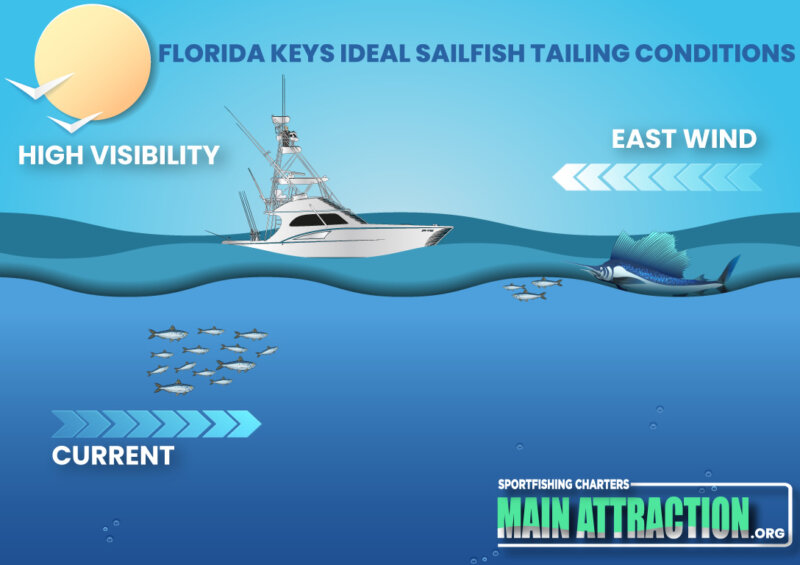
On days like this you don’t need to use Kite fishing or Bump Trolling to raise Sailfish the current has already done this for you! Instead of waiting for a Sailfish to find you, you can find it instead. When you start hearing boats catching multiple Sailfish in high numbers, you can bet it’s because of a tailing condition. This is why most of our boats have tall towers. It helps our Captains spot Sailfish in the waves or frightened schools of bait Spraying to get away. The towers also help our captains verify whether or not it is a Sailfish making the baitfish nervous or another predator such as barracuda or mackerel.
When our Captains pull up to a Sailfish, the Mate has a live bait loaded and ready to pitch. This often occurs in the mid to late spring, so most of the time, a large Pilchard is what our Mates will be pitching. Pilchards are what we are catching this time of year and what Captain Marty has found works most consistently this time of year. If the Sailfish turn a bait down several times the Captain may ask the Mate to switch to another bait type to see if they can trigger a bite with it.
While Sailfish are plentiful in this tailing condition, they aren’t all going to be hungry. Some are focused on traveling, not hungry, or recovering from the stress of recently being caught and released. There are days when you go out in a tailing condition and pitch baits to Sailfish all day and only get a few bites which can be very frustrating. But, there are also days when they are all biting, which is incredible. In April 2020, Captain Marty and Crew successfully caught and released 70 Sailfish in a single day! In May 2018, Captain Marty and his crew caught and released 61 Sailfish in a single day.
Main Attraction Co-Owner Katie Lewis recently looked back at one of her favorite Sailfish trips on video and said:
“Several years ago, Captain Marty and I were fishing together. We were high up in the tuna tower when we spotted what looked like a black trashbag bag floating in the water. Which is precisely what a Sailfish looks like while near the surface.
Marty pulled up alongside the Sailfish, and the Mate pitched a live ballyhoo which was eaten immediately. Before we caught the first Sail, we spotted another fish from the tower. Marty was excited now, yelling to his Mate to get another bait. That fish ate, and was hooked up, so now we’re fighting two fish simultaneously.
That pattern continued throughout the afternoon that day. Captain Marty kept finding fish one after another. I had to come down from the tower to help fight Sailfish too! It was one hungry Sailfish after another. It was pure mayhem, a beautiful, chaotic, action-packed afternoon.
That afternoon happened to be when the Sailfish started tailing, so in a matter of a few hours, the boat had caught and released 17 sailfish. It was an incredible experience, and if you are lucky enough to be in the Florida Keys at the right time, I promise you will NEVER forget it. Your adrenaline is pumping the entire time, and it’s so much fun you don’t even realize how exhausted you are until it’s over!”
Bump Trolling
If kite fishing and sight fishing had a baby, it would be bump trolling! If there is not enough wind to fly a kite or not enough sunlight to sight fish, bump trolling can be the answer. Bump trolling is looking for signs of fish or bait, running to that area, and putting out some live bait hoping the fish will see it and swim up to it. When bump trolling, you still put out the baits in a spread as you would in Kite fishing, just without the kites and with less lines. If Captain Marty sees a shower of bait or a spray, as we call it, he will run to it. Once he gets there, if it’s cloudy and he can’t see the fish he will have his Mate throw out some flat lines and a few rigger lines and drift. This style of fishing does not allow time to set up kites because the Captain is jumping from one area to the next. If you try to troll with live bait like you would drag a lure, the bait would die very quickly. So instead, our Captains keep the motors in neutral and bump them in and out of gear to keep the boat facing into the wind (check Marty) to do a controlled drift hoping to raise the fish they spotted.
Bump trolling is also effective on sunlit days if you don’t have a tall tower or kite-fishing equipment. You can also bump troll with either conventional or spinning rods. If you need help determining where to bump-troll, Captain Marty suggests bump-trolling in approximately 120′ of water right off the reef line and looking for bait sprays to chase down.
Conclusion
So as you can see, there are many practical ways to target Sailfish in the Florida Keys, but the time of year and conditions dictate the best course of action on any given day. You may expect to Kite fish in December, but there is always a chance there won’t be enough wind or something unexpected like a tailing condition in the winter.
This is why the secret to successful Sailfishing in the Florida Keys is having the right live bait and knowing how to present it once you identify the conditions of the day.
Alternatively, you can leave all the hard work and prep to us, and focus on the fun part, fighting the fish! If you book a charter with the Main Attraction, relax, drink a beer, and share some laughs with your loved ones while we care for the rest! If you have any questions or comments, call us at 305-289-0071 or visit our contact page.




